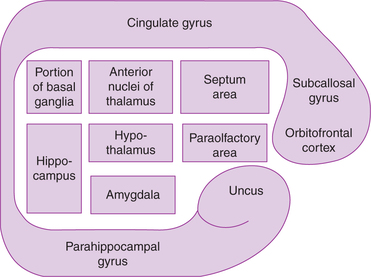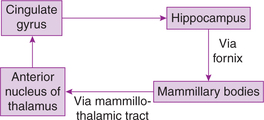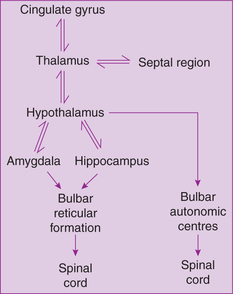Limbic System and Physiology of Emotional, Behavioural and Motivational Mechanisms
Limbic system
Physiological anatomy
Components of limbic system
The term limbic has been derived from the word ‘limbus’, which means a ring. Thus, the term limbic system is applied for those parts of the cortex (limbic cortex or limbic lobe) and subcortical structures that form a ring around the brain stem. The components of limbic system are (Fig. 10.7-1) the following.
Limbic cortex, or the so-called limbic lobe, surrounds the subcortical structures of the limbic system. Phylogenetically, limbic cortex is an older part of the cerebral cortex (allocortex), having primitive histological structures. Limbic cortex is composed of (Figs 10.7-1 and Fig. 10.7-2):
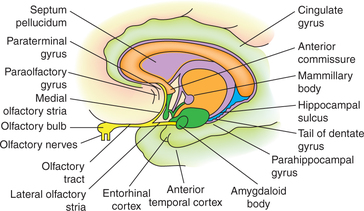
Fig. 10.7-2 Medial surface of right cerebral hemisphere showing limbic cortex (limbic lobe) and other components of limbic system.
Connections
Papez circuit refers to a closed circuit formed by connections between the cingulate gyrus (located in the prefrontal lobe), hippocampus, mammillary bodies and anterior nucleus of thalamus (Fig. 10.7-3). This circuit is responsible for resting EEG and for those emotions and aspects of behaviour that are related to preservation of the individual and species.
Efferent projection of limbic system is shown in Fig. 10.7-4.
Characteristic features of limbic system connections
• Limbic system has very little connection with the neocortex. Because of this emotional and instinctual behaviour is not under voluntary control, especially in lower animals. Thus, from a functional point of view, neocortical activity does modify emotional behaviour but it cannot be turned on and off at will.
• Prolonged after discharge is shown by the anatomic closed circuit of the limbic system following a sensory experience. Therefore, the emotional responses are usually prolonged, i.e. continue long after the end of the stimuli that produce them.
Functions of limbic system
Most of the functions of limbic system are intimately related to the functions of hypothalamus, which have been described in Chapter 10.1, page 484.
1. Autonomic functions
Stimulation of many parts of the limbic system, especially that of amygdala, produces autonomic responses, such as changes in cardiovascular, respiratory and gastrointestinal system through hypothalamus. Such changes are also observed during the emotional states. Autonomic functions of hypothalamus are described on page 483.
2. Regulation of feeding behaviour
Limbic system regulates feeding behaviour mainly through hypothalamus and amygdala.
3. Regulation of sexual behaviour and reproduction
Sexual behaviour, the basic sex drive (urge to copulate), is an instinctual behaviour as food intake. It is the function of limbic system and hypothalamus, which in turn are influenced by gonadal hormones and cerebral cortex.
4. Maternal behaviour
Maternal behaviour is the function of cingulate gyrus and retrosplenial portion of the limbic cortex. In animals, maternal behaviour is primarily neurogenic, i.e. it depends on the olfactory, auditory, visual and thermotactile stimuli arising from the young ones. Prolactin and oxytocin, though absolutely not essential, have been reported to facilitate maternal behaviour. In general, the maternal behaviour is concerned with the nursing (breastfeeding) and protection of the offspring by the mother.
Physiology of emotions
Components of emotions
Emotions refer to an aroused state involving intense feeling, autonomic activation and related behaviour, which accompany many of our conscious experiences. Emotions have two major components: mental and physical.
I. Mental or sensory component
Mental or sensory component of emotions comprises cognition, affect and conation.
Cognition. It refers to a phenomenon by which one becomes aware (sees) and recognizes a situation. For example, when an individual hears a sudden loud noise and from his experience recognizes it to be bomb blast. This is called cognition.
Affect. It is a German word which means development of a feeling. In the above example, the person after cognizing the loud sound as bomb blast is frightened; this feeling of frightening is called affect.
Conation. It is the force which directs or urges to take some action. For example, the desire to run away from the site of loud noise after getting frightened is conation.
II. Physical or expressive or peripheral component
Physical or expressive or peripheral component of the emotions consists of two subcomponents—the somatic and autonomic.
Somatic part of the physical component of emotions basically comprises changes in the skeletal muscles. The accomplishment of the act of running away from the site of noise in the above example constitutes the somatic part of the physical component.
Autonomic part of the physical component of emotions involves the co-ordinated activity of sympathetic and parasympathetic nervous system. For example, occurrence of tachycardia, raised blood pressure, increased respiration rate, etc. after getting frightened from the sudden loud noise constitutes the autonomic part of the physical component.
• Sympathetic expression. Fear (as in the above example) is associated with sympathetic expression, which is characterized by an increase in the heart rate, increase in respiration rate, cutaneous vasoconstriction, sweating (cold sweat), piloerection, pupillary dilatation and dryness of mouth.
• Parasympathetic expression is noticed during grief or pleasure.
Note In many instances, the somatic part of the physical component of emotions may be absent. For example, after getting insulted and provoked, one may beat the insulter (somatic part present). While the other individual may feel enraged, develop high blood pressure plus tachycardia but restrains oneself and does not show any somatic side of expression (indeed, this is common in civilized societies).
Function served by peripheral component of emotions is that the body is prepared for action.
Theories of genesis of emotions
Physical changes are secondary to the emotional feelings or vice versa, and have been the matter of debate. Various theories have been put forward from time-to-time in this regard. The genesis of emotions as explained by Arnold is as follows.
Arnold theory. According to this theory of genesis emotions (Fig. 10.7-5):
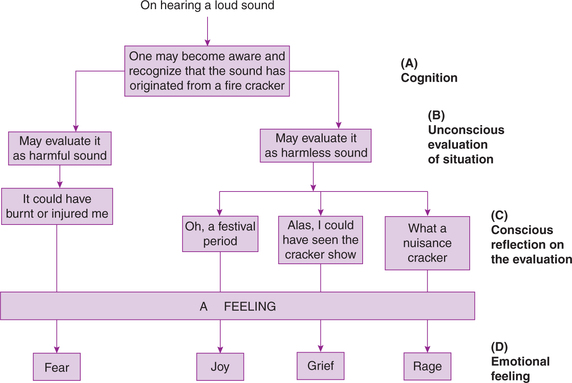
Fig. 10.7-5 Steps of Arnold's theory of emotions: A, cognition; B, unconscious evaluation of situation; C, conscious reflection on the evaluation and D, emotional feeling.
• By cognition, one becomes aware and recognizes a situation.
• By unconscious evaluation, the situation is judged as to be harmful or beneficial.
• Affect is conscious reflection of unconscious appraisal. A feeling is thus generated consciously in response to unconscious evaluation of a situation. Such a feeling may be in the form of fear, joy, grief or rage.
Thus, according to the Arnold's theory, emotions have their own logic and that the peripheral component of emotions results from an unconscious evaluation of situation as potentially harmful or harmless. Therefore, in response to a particular situation the different individuals react differently, e.g. in response to a bomb blast by terrorist attacks:
Further, Arnold pointed out that the autonomic responses are not an essential component of emotions.
Emotional behaviour
Different emotions produce different sets of behaviour. Behaviour is considered an expression of emotions. Some of the emotional behaviours are:
Neural substrate of emotions
1. Role of central nervous system
Cerebral cortex, especially the frontal, cingulate and parahippocampal cortices, play an important role in affective component of emotions:
Hypothalamus has been considered the main seat of emotions.
Areas of hypothalamus associated with behavioural control functions are:
• Increased level of general activity, leading to rage and aggression. It occurs when lateral hypothalamus is stimulated.
• Feeling of reward, tranquility and pleasure are appreciated when reward centre is stimulated.
• Fearing, feeling of punishment and aversion are felt when punishment centre is stimulated.
2. Role of peripheral nervous system
Autonomic as well as the somatic motor peripheral nervous system is involved in the peripheral expression of the emotions.
(i) Autonomic nervous system is the chief mediator of the emotional output. Cannon described the emotional response to an emergency or involving diffuse sympathetic activation and outpouring into the blood of excitatory substances, i.e. the catecholamines.
(ii) Somatic motor nervous system is involved in the somatic part of the physical component of emotions, which basically comprises changes in the skeletal muscles.
Physiology of motivation
Motivation is that component of behaviour, which is responsible for accomplishing a particular task.
Neural mechanism of motivation
Neural mechanisms involved in the motivation are based on the concept of reward and punishment. It has been elucidated by the effects of self-stimulation of brain.
Concept of reward and punishment
Almost anything that we do is related in some way to reward and punishment. If we do something that is rewarding, we continue to do it. If we do something that is punishing we cease to do it.
Reward and punishment centre. It appears that conditions which result in stimulation of reward centre produce motive to do a job.
Role of neurotransmitters
Neurotransmitters involved in the pathway that stimulate the reward centre are:
Drugs that increase stimulation of reward centre are those which increase synaptic activity in catecholamine pathway, e.g.
• Amphetamine, which causes increased release of dopamine,
• Nicotine and alcohol increase the amount of dopamine,
• Cocaine inhibits the re-uptake of dopamine and norepinephrine.
Drugs that decrease stimulation of reward centre are those which lower synaptic activity in the catecholamine pathway, e.g. chlorpromazine hydrochloride (Largactil).
